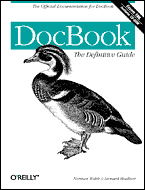DocBook: The Definitive Guide
By Norman Walsh & Leonard Muellner
DocBook: The Definitive Guide Prev Next
Name PartIntro -- An introduction to the contents of a part
Synopsis Content Model PartIntro ::= ((Title,Subtitle?,TitleAbbrev?)?, (((CalloutList|GlossList|ItemizedList|OrderedList|SegmentedList| SimpleList|VariableList|Caution|Important|Note|Tip|Warning| LiteralLayout|ProgramListing|ProgramListingCO|Screen|ScreenCO| ScreenShot|Synopsis|CmdSynopsis|FuncSynopsis|FormalPara|Para| SimPara|Address|BlockQuote|Graphic|GraphicCO|MediaObject| MediaObjectCO|InformalEquation|InformalExample|InformalFigure| InformalTable|Equation|Example|Figure|Table|MsgSet|Procedure| Sidebar|QandASet|Anchor|BridgeHead|Comment|Highlights| Abstract|AuthorBlurb|Epigraph|IndexTerm)+, (Sect1*| (RefEntry)*| SimpleSect*|Section*))| (Sect1+| (RefEntry)+| SimpleSect+|Section+))) Attributes Common attributes
Name
Type
Default
Label CDATA None
Tag Minimization The start-tag is required for this element. The end-tag is optional, if your SGML declaration allows minimization.
Description PartIntro contains introductory text, often an overview of the content of the Part .
Processing expectations Formatted as a displayed block. Sometimes suppressed.
PartIntro content is often printed on a part separator page.
Parents These elements contain PartIntro: Part , Reference .
Children The following elements occur in PartIntro: Abstract , Address , Anchor , AuthorBlurb , BlockQuote , BridgeHead , CalloutList , Caution , CmdSynopsis , Comment , Epigraph , Equation , Example , Figure , FormalPara , FuncSynopsis , GlossList , Graphic , GraphicCO , Highlights , Important , IndexTerm , InformalEquation , InformalExample , InformalFigure , InformalTable , ItemizedList , LiteralLayout , MediaObject , MediaObjectCO , MsgSet , Note , OrderedList , Para , Procedure , ProgramListing , ProgramListingCO , QandASet , RefEntry , Screen , ScreenCO , ScreenShot , Sect1 , Section , SegmentedList , Sidebar , SimPara , SimpleList , SimpleSect , Subtitle , Synopsis , Table , Tip , Title , TitleAbbrev , VariableList , Warning .
In some contexts, the following elements are allowed anywhere: BeginPage , IndexTerm .
Attributes
Label Label specifies an identifying string for presentation purposes.
Generally, an explicit Label attribute is used only if the processing system is incapable of generating the label automatically. If present, the Label is normative; it will used even if the processing system is capable of automatic labelling.
See Also Appendix , Article , Book , Chapter , Colophon , Dedication , Part , Preface , Set
Examples For examples, see Part .
Back to: DocBook: The Definitive Guide
O'Reilly Home | O'Reilly Bookstores | How to Order | O'Reilly Contacts International | About O'Reilly | Affiliated Companies © 1999, O'Reilly & Associates, Inc.
DocBook 5: The Definitive Guide
ISBN: 0596805020
Year: 1999
flylib.com © 2008-2017.
